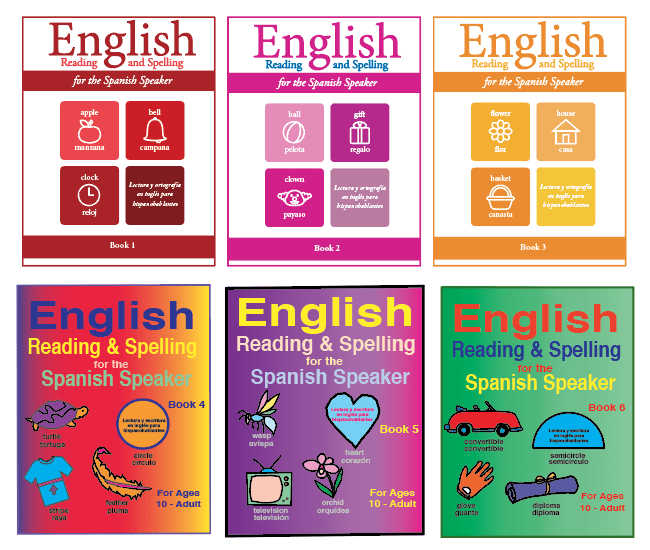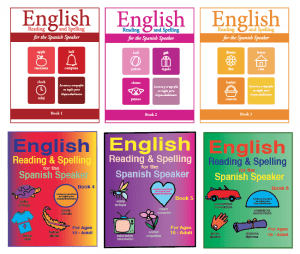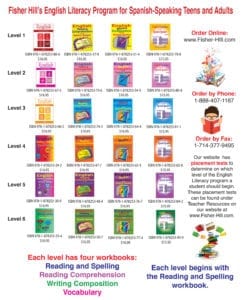Fisher Hill’s literacy workbooks use a structured literacy approach. All the books are based on Orton-Gillingham practices. Most of Fisher Hill’s workbooks are for Spanish-speaking teens and adults to learn to read and write in English.
Kathy Fisher is the owner of Fisher Hill and the author of the workbooks. She taught reading for 17 years. She is a member of the International Dyslexia Association and has two boys who had difficulty learning to read. One son graduated with a Ph.D. in Chemistry and the other son dropped out of high school, passed the high school proficiency test, and worked at Twitter before he was twenty years old making more money than his mother who had a master’s degree in Education. Needless to say, the boys school experiences at times were not a joyful affair especially with the younger one who finally dropped out of school when he was sixteen.
School can be extremely difficult for children who have a hard time learning to read. As a teacher, I loved teaching reading because I knew what to do. I joined IDA when my boys had difficulty learning to read. This reading difficulty came as a shock to me because I had read to them since they were babies. They had gone to Mommy and Me classes, story time at the library, and they had plenty of books at home. IDA taught me how to teach reading. They taught me about Orton-Gillingham. I knew what to do. I did not depend on the school’s textbooks to teach reading.
The workbooks I’ve written use a very structured, systematic, explicit approach to teach the English speech sounds to read and spell. The series called English Reading and Spelling for the Spanish Speaker uses phonics, phonemic awareness and other phonological skills to teach reading and spelling. This series has six workbooks. Each workbook has twenty lessons.
Each lesson begins with a word list that includes words with the targeted sound for that lesson. Many of these words can also be used as vocabulary words.
The next page in the lesson works with high frequency words. These words are often misspelled so they are presented and practiced repeatedly throughout the book.
The third page in the lesson is a fill in the blank page so students can practice using the words from the word list from the first page of the lesson and the high frequency words from the second page of the lesson. There are pictures from the first page of the lesson at the end of some of the fill in the blank sentences since many sentences could have more than one answer. Students use the pictures at the end of the sentence to know which word from the word list to use.
The fourth page of the lesson practices spelling, grammar, vocabulary or writing.
The fifth page of the lesson is a word search, crossword puzzle or jumble
The last page of the lesson is an answer key.
How to use the workbooks:
When I was teaching reading and spelling, I spent two days on each new sound. I would begin the lesson by flashing sound spelling cards with the consonants and a card with the new sound. I would then dictate five words from the word list, five words from previous word lists (from the book) and two or three high frequency words. The students would write the words on their whiteboards and then read and spell the words back to me. The dialogue I used was:
Teacher: “Write the word cat.” (Students write the word.) “What word did you write?”
Students: cat
Teacher: “How do you spell cat?”
Students: “c-a-t”
I did this for each word and then I would dictate two sentences. These sentences can come from page 2 of each lesson. This type of multisensory practices helps students to learn and remember the sounds.
Visit us online at www.Fisher-Hill.com to view all of our workbooks. If you have any questions about our workbooks or how to navigate our website you can email us at [email protected] or call us at 1-888-407-1187.
Fisher Hill has an excellent English literacy program for Spanish-speaking teens and adults. The program has six levels. Each level has four workbooks:
a Reading and Spelling workbook
a Reading Comprehension workbook
a Writing Composition workbook
and a Vocabulary workbook

The workbooks are bilingual because the word list for each lesson is presented in English and Spanish. There are pictures to go with many of the words on the lists. Each lesson emphasizes one or two new speech sounds. The vowel sounds in English are different than those in Spanish, but many of the English consonant sounds are similar to those in Spanish. Most consonants in English have one sound. Vowels in English make several speech sounds. Sometimes the letter “y” is used as a vowel.
Each lesson starts with the Word list and then three or four pages to practice words with the new speech sounds. At the end of each lesson is an answer key.
In English Reading and Spelling for the Spanish Speaker Books 4, 5, and 6, prefixes and suffixes are introduced and practiced.
On our website, if you click on any workbook, you can view sample pages from that book.
On our website, there are placement tests to determine on which level a student should begin the literacy program. A student needs a score of 80% to go to the next level. For example, if a student gets 60% on the placement test for level one, then that student needs to begin with level one with English Reading and Spelling for the Spanish Speaker Book 1. Each level begins with the Reading and Spelling workbook.
These placement tests can be found under Teacher Resourceson our website www.Fisher-Hill.com. Teacher Resourcescan be found on the top tool bar. Click on Teacher Resources, then click on Reading and Spelling. Then scroll down to the placement tests. The placement tests are called Sound Spelling Placement Test Book 1 and so forth. Sound Spelling Placement Test Book 1 is for level one. You will also find instructions on how to give the tests.
There are other teacher resources for these workbooks under Reading and Spelling. There is a Scope and Sequence to help you use the workbooks. There are Word and Sentence Practice pages and Word Chains to help with fluency.
Visit us online at www.Fisher-Hill.comto view all of our workbooks. If you have any questions about our workbooks or how to navigate our website you can email us at [email protected]or call us at 1-888-407-1187.
Fisher Hill has many workbooks to help Spanish-speaking teens and adults learn English. Fisher Hill now has a Spanish side to their website.
Visit our website at www.Fisher-Hill.com. To view our website in Spanish, click on the word Español on the top toolbar in the right corner. On the Spanish side of the webpage, only ebooks can be downloaded. If you want a hard copy of the books, you can order those from the English side of the website.
To navigate through our website,
- first put in the address www.Fisher-Hill.com. This will bring you to the English side.
- From the top toolbar, you can click on Fisher Hill Store.
- Then scroll down to click on the different workbook topics. You can then click on a workbook. This will bring you to a page that will give you information about the workbook.
- On this page, you can click on Sample Pages to view pages from the workbook. There is also an option where you can choose to purchase a hardcopy of the book or ebook.
On the English side of www.Fisher-Hill.com, on the top toolbar, you can click on Teacher Resources. This will bring you to a page where you can view sample pages or lessons from each workbook. Under Reading and Spelling, there are activities, for example: Word and Sentence Practice with the Short /a/ Sound. Also under Reading and Spelling, are six Placement Tests and instructions on how to use the Placement Tests that go with our English Literacy Program for Spanish-Speaking teens and Adults: Instructions for Sound Spelling Placement Tests, and Sound Spelling Placement Test Book 1.
From the Home Page, you can click on any book to take you to it’s page and then if you click again on the book, it will take you to more information about the book.
On the Spanish side of www.Fisher-Hill.com, from the top toolbar, you can click on Recursos Para Los Maestros, to find the Placement Tests for our English Literacy Program for Spanish Speaking Teens and Adults, Clave de respuestas de la prueba de deletreo fonético Nivel 1. There are instructions in Spanish on how to use these Placement Tests Pruebas de determinación del nivel de deletreo fonético
If you have difficulty navigating through our website, you can call us at 1-888-407-1187 or email us at [email protected]
Fisher Hill has a six workbook series called English Reading and Spelling for the Spanish Speaker. This reading and spelling ESL workbook series
The workbooks are bilingual since the word list for each lesson is presented in English and Spanish. There are pictures to go with many of the words in the lists. Each lesson emphasizes one or two new speech sounds. The vowel sounds in English are different than those in Spanish, but many of the English consonant sounds are similar to those in Spanish. Most consonants in English have one sound. Vowels can make several speech sounds. Sometimes the letter “y” is used as a vowel.
Words are made up of syllables (units of pronunciation). Some words have one syllable, others have two or more syllables. Every syllable must have a vowel sound. If a word has three syllables then it has three vowel sounds.
Each lesson’s word list begins with words that contain the speech sound that is being emphasized in that lesson. The last two words in the list are sight words.
Practicing English speech sounds, sight words, and their spellings will help Spanish speakers learn English reading and spelling.
In English Reading and Spelling for the Spanish Speaker Books 4, 5, and 6, prefixes and suffixes are introduced and practiced.
On our website, there are placement tests to determine which level a student should begin. A student needs a score of 80% on the placement test to go to the next level. For example, if a student gets 60% on the placement test for level one, then that student needs to begin with level one with English Reading and Spelling for the Spanish Speaker Book 1. Each level begins with the Reading and Spelling workbook.
These placement tests can be found under Teacher Resources on our website www.Fisher-Hill.com. Teacher Resources can be found on the top tool bar. Click on Teacher Resources, then click on Reading and Spelling. Then scroll down to the placement tests. The placement tests are called Sound Spelling Placement Test Book 1 and so forth. Sound Spelling Placement Test Book 1 is for level one. The Sound Spelling Placement Tests are spelling tests to determine if a student has mastered the sounds for that level. The teacher or volunteer gives the spelling test to the student. There are also student test forms under Teacher Resources.
There are other teacher resources for these reading and spelling ESL workbooks on our website. There

Visit us
Scope and Sequence for English Reading and Spelling for the Spanish Speaker
Fisher Hill’s English literacy program for Spanish-speaking teens and adults has six levels to help Spanish speakers acquire English literacy skills. Each level has four workbooks:
Reading and Spelling
Reading Comprehension
Writing Composition
Vocabulary
At each level, the English Reading and Spelling for the Spanish Speaker workbook comes first. After students have completed this workbook, they can do the reading comprehension, writing composition and vocabulary workbooks at that level.
At Fisher Hill’s website www.Fisher-Hill.com, click on Teacher Resources on the top tool bar on the home page. Then click on Reading and Spelling. Scroll down to Scope and Sequence and click on it. The Scope and Sequence gives activities to do with the reading and spelling workbooks and also presents the sounds introduced and practiced in each workbook. The sounds are the ones that will be practice at each level of the program.
If you have difficulty finding the Scope and Sequence for the English reading and spelling workbooks, you can email your questions to [email protected] and someone will respond within 24 hours or call us and someone will walk you through the website.
Below is the Scope and Sequence for the English Reading and Spelling for the Spanish Speaker workbooks.
Scope and Sequence
for the
English Reading and Spelling for the Spanish SpeakerSeries
Before beginning English Reading and Spelling for the Spanish Speaker Book 1, practice the consonant sounds below with your students. Many of the consonant sounds are the same in English as in Spanish. The letters: q, w, x and y have been left off this list because they are introduced and practiced in English Reading and Spelling for the Spanish Speaker Book 1.
Bb says /b/ as in boy.
Cc says /c/ as in cat.
Dd says /d/ as in dog.
Ff says /f/ as in fun.
Gg says /g/ as in goat.
Hh says /h/ as in house.
Jj says /j/ as in jump.
Kk says /k/ as in kite.
Ll says /l/ as in lion.
Mm says/m/ as in mat.
Nn says/ n/ as in no.
Pp says /p/ as in pet.
Rr says /r/ as in run.
Ss says /s/ as in sun.
Tt says /t/ as in top.
Vv says /v/ as in van.
Zz says /z/ as in zoo.
To help your students obtain automaticity with these sounds, you can use flash cards, graphic organizers or smart boards.
Students need to know that both upper and lower case letters make the same sound.
This is a graphic organizer for the sound of letter s. Students can work together to make graphic organizers for each of the consonants listed above.
The teacher can use a smart board for the students to practice their letter sounds or students can write their own letters to practice the letter sounds. From left to right, students read the sounds.
On the following pages are the sounds, words, prefixes, suffixes, roots, and spelling rules that are presented in each of the six workbooks.
English Reading and Spelling for the Spanish Speaker Book 1
Short vowel sound for the letter a
Short vowel sound for the letter i
Short vowel sound for the letter o
Words with x
Words that end with ay
Short vowel sound for the letter u
Long vowel sound for espelled ee
Short vowel sound for the letter e
Words with w and y
Words with sh
The FISL Spelling Rule
Words that end with ck
Words with qu
Beginning Blends: st, sm, sp, sw, sc, sn,
bl, cl, pl, fl, gl, sl, cr, tr, fr, dr, br, pr, gr
English Reading and Spelling for the Spanish Speaker Book 2
Long vowel sound for ispelled ay
Words with the long vowel sound for eand oat the end of short words
Words with ch
Vowel sound or
Words that end with all
The thsound
Words that end with ing, ang,ong, ung
The vowel sounds for oyand ar
The wh sound
Words that end with ink, ank, onk, unk
Vowel sound for ooas in food
Words with the vowel-consonant-e (VCe) pattern
Ending Blends: st, nd, nt, mp, sk, ft, lt, lk, sp, ct
The owvowel sound as in show
Words with the long vowel sound for aspelled ai
Compound Words
The owvowel sound as in cow
The oovowel sound as in book
On pages 31, 62, 93 and 124 are Spelling Checks. The teacher dictates the words to the students who write the words and then read the words back to the teacher.
English Reading and Spelling for the Spanish Speaker Book 3
The ingsuffix
Words with the ervowel sound and the ersuffix
Words with tch
Words with dge
Words with the awvowel sound
Words with the vowel team oa
Words with oivowel sound
The soft csound
The soft gsound
The vowel team ea
The ewvowel sound
The earvowel sound
The long ivowel sound spelled igh
The ouvowel sound
Words with two syllables
On pages 31, 62, 93 and 124 are Spelling Checks. The teacher dictates the words to the students who write the words and then read the words back to the teacher.
English Reading and Spelling for the Spanish Speaker Book 4
Words with the irvowel sound
Suffixes: s, es, ed, y, ly, tion, less, ness, ment, ful, et, en, ic, est, ous, al
Prefixes: in, re, a, un, de, be, ex, e, con, dis, com, en, pre, pro, per, sub
Blends: scr, shr, spl, spr, squ, str, thr
The consonant –lesyllable
Words with the urvowel sound
Words with ind and ild
Words with oldand ost
Words with the short evowel sound spelled ea
The ervowel sound spelled ear
The Doubling Spelling Rule
On pages 31, 62, 93 and 124 are Spelling Checks. The teacher dictates the words to the students who write the words and then read the words back to the teacher.
English Reading and Spelling for the Spanish Speaker Book 5
Contractions
Suffixes: sion, ive, ist, hood, dom, ward, ling, some, ture, ard, ify, ical
The vowel sound au
Words with ph
Words with the vowel spelling ue
Words with wr, kn,and gn
The Y Rule
The spelling rule for ie
Months of the Year
Words with the long evowel sound
Words with the long avowel sound
Words with warand wor
Words with wa, aughand ough
The /k/ sound spelled ch
Words with mband stle
Prefixes: for, fore, over, auto, para, post, with, tele, trans
On pages 31, 62, 93 and 124 are Spelling Checks. The teacher dictates the words to the students who write the words and then read the words back to the teacher.
English Reading and Spelling for the Spanish Speaker Book 6
Suffixes: or, ar
Roots: port, tract, form, spect, ject, struct, dic, dict, duct, duc, duce, scrib, script, face, fact, fer, rupt, mit, miss, flect, flex, vert, vers, pel, puls, vis, vid, cap, cept, celt, ceive
Two-syllable Doubling Rule
Prefixes: uni, mono, bi, di, tri, poly, dec, deci, cent, multi, semi
On pages 31, 62, 93 and 124 are Spelling Checks. The teacher dictates the words to the students who write the words and then read the words back to the teacher.


Visit our website at www.Fisher-Hill.com to view our English Reading and Spelling for the Spanish Speaker workbooks which are the first books to use at each level. There are sample lessons from each workbook that can be downloaded.

 Fisher Hill has four Reading and Spelling Workbooks. On our website at
Fisher Hill has four Reading and Spelling Workbooks. On our website at 
